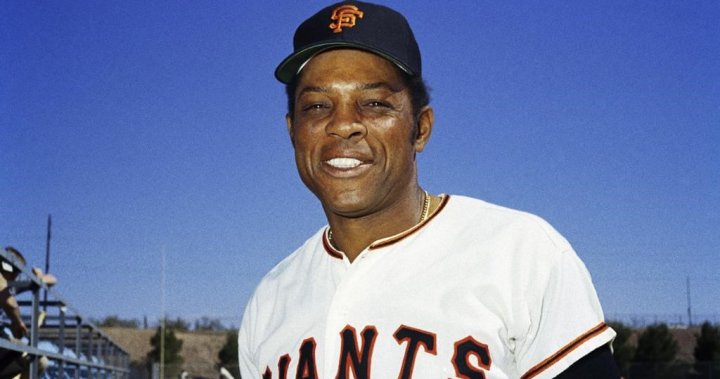Willie Mays, the electrifying “Say Hey Kid” whose singular combination of talent, drive and exuberance made him one of baseball’s greatest and most beloved players, has died. He was 93.
Mays’ family and the San Francisco Giants jointly announced Tuesday night he had died earlier in the afternoon in the Bay Area.
“My father has passed away peacefully and among loved ones,” son Michael Mays said in a statement released by the club. “I want to thank you all from the bottom of my broken heart for the unwavering love you have shown him over the years. You have been his life’s blood.”
The centerfielder, who began his professional career in the Negro Leagues in 1948, was baseball’s oldest living Hall of Famer. He was voted into the Hall in 1979, his first year of eligibility, and in 1999 followed only Babe Ruth on The Sporting News’ list of the game’s top stars. The Giants retired his uniform number, 24, and set their AT&T Park in San Francisco on Willie Mays Plaza.
Mays died two days before a game between the Giants and St. Louis Cardinals to honor the Negro Leagues at Rickwood Field in Birmingham, Alabama.
“All of Major League Baseball is in mourning today as we are gathered at the very ballpark where a career and a legacy like no other began,” Commissioner Rob Manfred said. “Willie Mays took his all-around brilliance from the Birmingham Black Barons of the Negro American League to the historic Giants franchise. From coast to coast … Willie inspired generations of players and fans as the game grew and truly earned its place as our National Pastime.”
Few were so blessed with each of the five essential qualities for a superstar — hitting for average, hitting for power, speed, fielding and throwing. Fewer so joyously exerted those qualities — whether launching home runs; dashing around the bases, loose-fitting cap flying off his head; or chasing down fly balls in centerfield and finishing the job with his trademark basket catch.
Over 23 major league seasons, virtually all with the New York/San Francisco Giants but also including one in the Negro Leagues, Mays batted .301, hit 660 home runs, totaled 3,293 hits, scored more than 2,000 runs and won 12 Gold Gloves. He was Rookie of the Year in 1951, twice was named the Most Valuable Player and finished in the top 10 for the MVP 10 other times. His lightning sprint and over-the-shoulder grab of an apparent extra base hit in the 1954 World Series remains the most celebrated defensive play in baseball history.
“When I played ball, I tried to make sure everybody enjoyed what I was doing,” Mays told NPR in 2010. “I made the clubhouse guy fit me a cap that when I ran, the wind gets up in the bottom and it flies right off. People love that kind of stuff.”
For millions in the 1950s and ’60s and after, the smiling ball player with the friendly, high-pitched voice was a signature athlete and showman during an era when baseball was still the signature pastime. Awarded the Medal of Freedom by President Barack Obama in 2015, Mays left his fans with countless memories. But a single feat served to capture his magic — one so untoppable it was simply called “The Catch.”
In Game 1 of the 1954 World Series, the then-New York Giants hosted the Cleveland Indians, who had won 111 games in the regular season and were strong favorites in the postseason. The score was 2-2 in the top of the eighth inning. Cleveland’s Vic Wertz faced reliever Don Liddle with none out, Larry Doby on second and Al Rosen on first.
With the count 1-2, Wertz smashed a fastball to deep center field. In an average park, with an average center fielder, Wertz would have homered, or at least had an easy triple. But the center field wall in the eccentrically shaped Polo Grounds was more than 450 feet away. And there was nothing close to average about the skills of Willie Mays.
Decades of taped replays have not diminished the astonishment of watching Mays race toward the wall, his back to home plate; reach out his glove and haul in the drive. What followed was also extraordinary: Mays managed to turn around while still moving forward, heave the ball to the infield and prevent Doby from scoring even as Mays spun to the ground. Mays himself would proudly point out that “the throw” was as important as “the catch.”
“Soon as it got hit, I knew I’d catch the ball,” Mays told biographer James S. Hirsch, whose book came out in 2010.
Breaking news from Canada and around the world
sent to your email, as it happens.
“All the time I’m running back, I’m thinking, ‘Willie, you’ve got to get this ball back to the infield.’”
“The Catch” was seen and heard by millions through radio and the then-emerging medium of television, and Mays became one of the first Black athletes with mass media appeal. He was a guest star on “The Donna Reed Show,” “Bewitched” and other sitcoms. He inspired a handful of songs and was named first in Terry Cashman’s 1980s novelty hit, “Talkin’ Baseball (Willie, Mickey & The Duke),” a tribute in part to the brief era when New York had three future Hall of Famers in center: Mays, Mantle of the Yankees and Snider of the Brooklyn Dodgers.
The Giants went on to sweep the Indians, with many citing Mays’ play as the turning point. The impact was so powerful that 63 years later, in 2017, baseball named the World Series Most Valuable Player after him even though it was his only moment of postseason greatness. He appeared in three other World Series, in 1951 and 1962 for the Giants and 1973 for the Mets, batting just .239 with no home runs in the four series. (His one postseason homer was in the 1971 National League playoffs, when the Giants lost to the Pittsburgh Pirates).
But “The Catch” and his achievements during the regular season were greatness enough. Yankees and Dodgers fans may have fiercely challenged Mays’ eminence, but Mantle and Snider did not. At a 1995 baseball writers dinner in Manhattan, with all three at the dais, Mantle raised the eternal question: Which of the three was better?
“We don’t mind being second, do we, Duke?” he added.
Between 1954 and 1966, Mays drove in 100 or more runs 10 times, scored 100 or more 12 times, hit 40 or more homers six times, more than 50 homers twice and led the league in stolen bases four times. His numbers might have been bigger. He missed most of 1952 and all of 1953 because of military service, quite possibly costing him the chance to overtake Ruth’s career home run record of 714, an honor that first went to Henry Aaron; then Mays’ godson, Barry Bonds. He likely would have won more Gold Gloves if the award had been established before 1956. He insisted he would have led the league in steals more often had he tried.
“I am beyond devastated and overcome with emotion. I have no words to describe what you mean to me,” Bonds wrote on Instagram.
Mays was fortunate in escaping serious injury and avoiding major scandal, but he endured personal and professional troubles. His first marriage, to Marghuerite Wendell, ended in divorce. He was often short of money in the pre-free agent era, and he received less for endorsements than Mantle and other white athletes. He was subject to racist insults and his insistence that he was an entertainer, not a spokesman, led to his being chastised by Jackie Robinson and others for not contributing more to the civil rights movement. He didn’t care for some of his managers and didn’t always appreciate a fellow idol, notably Aaron, his greatest contemporary.
“When Henry began to soar up the home-run chart, Willie was loathe to give even a partial nod to Henry’s ability, choosing instead to blame his own performance on his home turf, (San Francisco’s) Candlestick Park, saying it was a lousy park in which to hit homers and this was the reason for Henry’s onrush,” Aaron biographer Howard Bryant wrote in 2010.
Admirers of Aaron, who died in 2021, would contend that only his quiet demeanour and geographical distance from major media centres — Aaron played in Atlanta and Milwaukee — kept him from being ranked the same as, or even better than Mays. But much of the baseball world placed Mays above all. He was the game’s highest-paid player for 11 seasons (according to the Society for American Baseball Research) and often batted first in All-Star Games, because he was Willie Mays. From center field, he called pitches and positioned other fielders. He boasted that he relied on his own instincts, not those of any coach, when deciding whether to try for an extra base.
Sports writer Barney Kremenko has often been credited with nicknaming him “The Say Hey Kid,” referring to Mays’ spirited way of greeting his teammates. Moments on and off the field sealed the public’s affection. In 1965, Mays defused a horrifying brawl after teammate Juan Marichal clubbed Los Angeles Dodgers catcher John Roseboro with a bat. Mays led a bloodied Roseboro away and sat with him on the clubhouse bench of the Dodgers, the Giants’ hated rivals.
FILE – New York Giants’ Willie Mays poses for a photo during baseball spring training in 1972. Mays, the electrifying “Say Hey Kid” whose singular combination of talent, drive and exuberance made him one of baseball’s greatest and most beloved players, has died.
AP Photo, File
Years earlier, when living in Manhattan, he endeared himself to young fans by playing in neighborhood stickball games.
“I used to have maybe 10 kids come to my window,” he said in 2011 while visiting the area of the old Polo Grounds. “Every morning, they’d come at 9 o’clock. They’d knock on my window, get me up. And I had to be out at 9:30. So they’d give me a chance to go shower. They’d give me a chance to eat breakfast. But I had to be out there at 9:30, because that’s when they wanted to play. So I played with them for about maybe an hour.”
He was born in Westfield, Alabama, in 1931, the son of a Negro League player who wanted Willie to do the same, playing catch with him and letting him sit in the dugout. Young Mays was so gifted an athlete that childhood friends swore that basketball, not baseball, was his best sport.
By high school he was playing for the Birmingham Black Barons, and late in life would receive an additional 10 hits to his career total, 3,293, when Negro League statistics were recognized in 2024 by Major League Baseball. With Robinson breaking the major league’s color barrier in 1947, Mays’ ascension became inevitable. The Giants signed him after he graduated from high school (he had to skip his senior prom) and sent him to their minor league affiliate in Trenton, New Jersey. He began the 1951 season with Minneapolis, a Triple-A club. After 35 games, he was batting a head-turning .477 and was labeled by one scout as “the best prospect in America.” Giants Manager Leo Durocher saw no reason to wait and demanded that Mays, barely 20 at the time, join his team’s starting lineup.
Durocher managed Mays from 1951-55 and became a father figure — the surly but astute leader who nurtured and sometimes pampered the young phenom. As Durocher liked to tell it, and Mays never disputed, Mays struggled in his first few games and was ready to go back to the minors.
“In the minors I’m hitting .477, killing everybody. And I came to the majors, I couldn’t hit. I was playing the outfield very, very well, throwing out everybody, but I just couldn’t get a hit,” Mays told the Academy of Achievement, a Washington-based leadership center, in 1996. “And I started crying, and Leo came to me and he says, ‘You’re my center fielder; it doesn’t make any difference what you do. You just go home, come back and play tomorrow.’ I think that really, really turned me around.”
Mays finished 1951 batting .272 with 20 home runs, good enough to be named the league’s top rookie. He might have been a legend that first season. The Giants were 13 games behind Brooklyn on Aug. 11, but rallied and tied the Dodgers, then won a best-of-3 playoff series with one of baseball’s most storied homers: Bobby Thomson’s shot in the bottom of the ninth off Ralph Branca.
Mays was the on-deck batter.
“I was concentrating on Branca, what he was throwing, what he might throw me,” Mays told The New York Times in 2010. “When he hit the home run, I didn’t even move.
“I remember all the guys running by me, running to home plate, and I’m saying, ‘What’s going on here?’ I was thinking, ‘I got to hit!‘”
FILE – New York Mets’ Willie Mays poses on May 12, 1972 in New York. Mays, the electrifying “Say Hey Kid” whose singular combination of talent, drive and exuberance made him one of baseball’s greatest and most beloved players, has died.
AP Photo/Harry Harris, File
His military service the next two years stalled his career, but not his development. Mays was assigned as a batting instructor for his unit’s baseball team and, at the suggestion of one pupil, began catching fly balls by holding out his glove face up, around his belly, like a basket. Mays adopted the new approach in part because it enabled him to throw more quickly.
He returned full time in 1954, hit 41 homers and a league-leading .345. He was only 34 when he hit his 500th career homer, in 1965, but managed just 160 over the next eight years. Early in the 1972 season, with Mays struggling and the Giants looking to cut costs, the team stunned Mays and others by trading its marquee player to the New York Mets, returning him to the city where he had started out in the majors.
Mays’ debut with his new team could not have been better scripted: He hit a go-ahead home run in the fifth inning against the visiting Giants, and helped the Mets win 5-4. But he deteriorated badly over the next two seasons, even falling down on occasion in the field. Many cited him as example of a star who stayed too long.
In retirement, he mentored Bonds and defended him against allegations of using steroids. Mays himself was in trouble when Commissioner Bowie Kuhn banned him from the game, in 1979, for doing promotional work at the Bally’s Park Place Hotel and Casino in Atlantic City, New Jersey. (Kuhn’s successor, Peter Ueberroth, reinstated Mays and fellow casino promoter Mantle in 1985).
But tributes were more common and they came from everywhere — show business, sports, the White House. In the 1979 movie “Manhattan,” Woody Allen’s character cites Mays as among his reasons for living. When Obama learned he was a distant cousin of political rival and former Vice President Dick Cheney, he lamented that he wasn’t related to someone “cool,” like Mays.
“Willie Mays wasn’t just a singular athlete, blessed with an unmatched combination of grace, skill and power,” Obama said Tuesday on X. “He was also a wonderfully warm and generous person — and an inspiration to an entire generation.”
Asked about career highlights, Mays inevitably mentioned “The Catch,” but also cherished hitting four home runs in a game against the Braves; falling over a canvas fence to make a catch in the minors; and running into a fence in Brooklyn’s Ebbets Field while chasing a bases-loaded drive, knocking himself out, but still holding on to the ball.
Most of the time, he was happy just being on the field, especially when the sun went down.
“I mean, you had the lights out there and all you do is go out there, and you’re out there by yourself in center field,” he told the achievement academy. “And, I just felt that it was such a beautiful game that I just wanted to play it forever, you know.”





